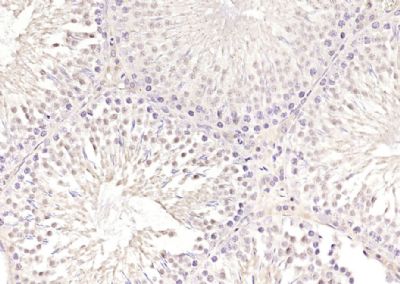SKA3 Polyclonal Antibody
Purified Rabbit Polyclonal Antibody (Pab)
- SPECIFICATION
- CITATIONS
- PROTOCOLS
- BACKGROUND

Application
| WB, IHC-P, IHC-F, IF, E |
|---|---|
| Primary Accession | Q8IX90 |
| Reactivity | Rat, Bovine |
| Host | Rabbit |
| Clonality | Polyclonal |
| Calculated MW | 46 KDa |
| Physical State | Liquid |
| Immunogen | KLH conjugated synthetic peptide derived from human SKA3 |
| Epitope Specificity | 201-300/412 |
| Isotype | IgG |
| Purity | affinity purified by Protein A |
| Buffer | 0.01M TBS (pH7.4) with 1% BSA, 0.02% Proclin300 and 50% Glycerol. |
| SUBCELLULAR LOCATION | Cytoplasm, cytoskeleton, spindle.Chromosome, centromere, kinetochore. Note=Localizes to the outerkinetochore and spindle microtubules during mitosis in a NDC80complex-dependent manner. |
| SIMILARITY | Belongs to the SKA3 family. |
| SUBUNIT | Component of the SKA1 complex, composed of SKA1, SKA2 andSKA3. The core SKA1 complex is composed of 2 SKA1-SKA2heterodimers, each heterodimer interacting with a molecule of theSKA3 homodimer. The core SKA1 complex associates with microtubulesand forms oligomeric assemblies. Interacts directly with SKA1. |
| Important Note | This product as supplied is intended for research use only, not for use in human, therapeutic or diagnostic applications. |
| Background Descriptions | Component of the SKA1 complex, a microtubule-binding subcomplex of the outer kinetochore that is essential for proper chromosome segregation. The SKA1 complex is a direct component of the kinetochore-microtubule interface and directly associates with microtubules as oligomeric assemblies. The complex facilitates the processive movement of microspheres along a microtubule in a depolymerization-coupled manner. In the complex, it mediates the microtubule-stimulated oligomerization. |
| Gene ID | 221150 |
|---|---|
| Other Names | Spindle and kinetochore-associated protein 3, SKA3, C13orf3, RAMA1 |
| Dilution | WB=1:500-2000,IHC-P=1:100-500,IHC-F=1:100-500,IF=1:100-500,ELISA=1:5000-10000 |
| Storage | Store at -20 ℃ for one year. Avoid repeated freeze/thaw cycles. When reconstituted in sterile pH 7.4 0.01M PBS or diluent of antibody the antibody is stable for at least two weeks at 2-4 ℃. |
| Name | SKA3 |
|---|---|
| Synonyms | C13orf3, RAMA1 |
| Function | Component of the SKA1 complex, a microtubule-binding subcomplex of the outer kinetochore that is essential for proper chromosome segregation (PubMed:19289083, PubMed:19360002, PubMed:23085020). The SKA1 complex is a direct component of the kinetochore-microtubule interface and directly associates with microtubules as oligomeric assemblies (PubMed:19289083, PubMed:19360002). The complex facilitates the processive movement of microspheres along a microtubule in a depolymerization-coupled manner (PubMed:19289083). In the complex, it mediates the microtubule- stimulated oligomerization (PubMed:19289083). Affinity for microtubules is synergistically enhanced in the presence of the ndc-80 complex and may allow the ndc-80 complex to track depolymerizing microtubules (PubMed:23085020). |
| Cellular Location | Cytoplasm, cytoskeleton, spindle. Chromosome, centromere, kinetochore Note=Localizes to the outer kinetochore and spindle microtubules during mitosis in a NDC80 complex-dependent manner |

Thousands of laboratories across the world have published research that depended on the performance of antibodies from Abcepta to advance their research. Check out links to articles that cite our products in major peer-reviewed journals, organized by research category.
info@abcepta.com, and receive a free "I Love Antibodies" mug.
Provided below are standard protocols that you may find useful for product applications.
If you have used an Abcepta product and would like to share how it has performed, please click on the "Submit Review" button and provide the requested information. Our staff will examine and post your review and contact you if needed.
If you have any additional inquiries please email technical services at tech@abcepta.com.













 Foundational characteristics of cancer include proliferation, angiogenesis, migration, evasion of apoptosis, and cellular immortality. Find key markers for these cellular processes and antibodies to detect them.
Foundational characteristics of cancer include proliferation, angiogenesis, migration, evasion of apoptosis, and cellular immortality. Find key markers for these cellular processes and antibodies to detect them. The SUMOplot™ Analysis Program predicts and scores sumoylation sites in your protein. SUMOylation is a post-translational modification involved in various cellular processes, such as nuclear-cytosolic transport, transcriptional regulation, apoptosis, protein stability, response to stress, and progression through the cell cycle.
The SUMOplot™ Analysis Program predicts and scores sumoylation sites in your protein. SUMOylation is a post-translational modification involved in various cellular processes, such as nuclear-cytosolic transport, transcriptional regulation, apoptosis, protein stability, response to stress, and progression through the cell cycle. The Autophagy Receptor Motif Plotter predicts and scores autophagy receptor binding sites in your protein. Identifying proteins connected to this pathway is critical to understanding the role of autophagy in physiological as well as pathological processes such as development, differentiation, neurodegenerative diseases, stress, infection, and cancer.
The Autophagy Receptor Motif Plotter predicts and scores autophagy receptor binding sites in your protein. Identifying proteins connected to this pathway is critical to understanding the role of autophagy in physiological as well as pathological processes such as development, differentiation, neurodegenerative diseases, stress, infection, and cancer.


